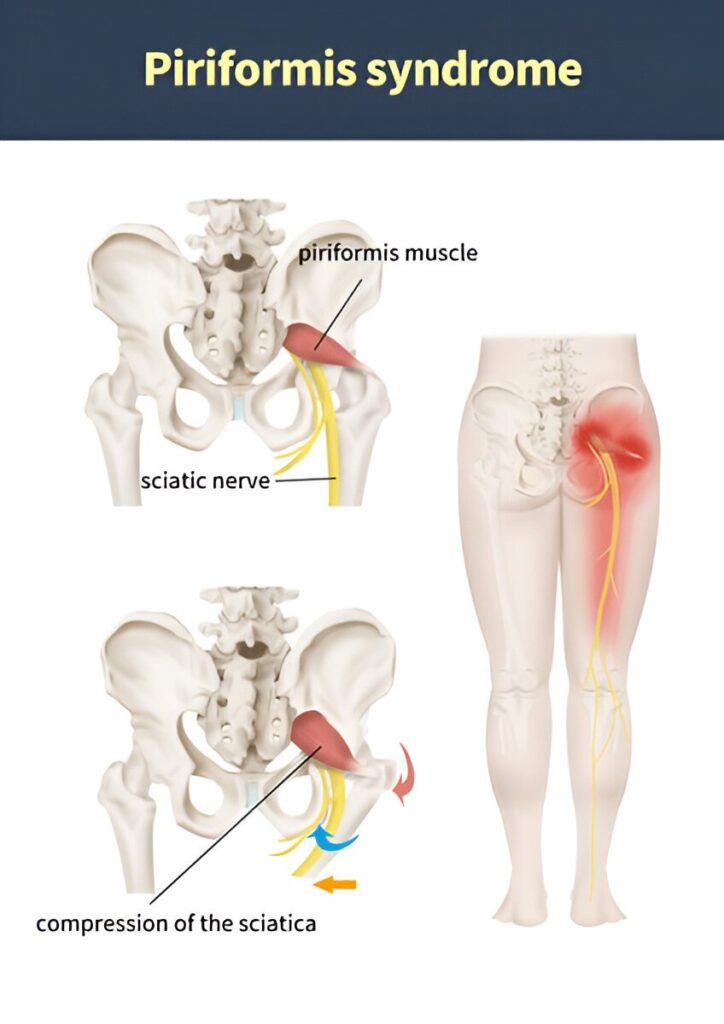
Piriformis Syndrome Physiotherapy: Relieving Glute and Sciatic Pain
Ever had a deep, nagging pain in your hips that shoots down your leg? Sounds like what piriformis syndrome feels like. It’s the kind of pain that makes sitting uncomfortable, walking difficult, and workouts miserable. The good news? Physiotherapy can fix it, if it’s done right.
Here’s the deal: this isn’t just about stretching a sore muscle. Piriformis syndrome involves a whole network of muscles, nerves, and movement patterns. Let’s break it down and see how the right physiotherapy approach gets you moving pain-free again.
What Is Piriformis Syndrome?
The piriformis is a small but strong muscle deep in your glute region. It connects your lower back to your thigh bone and helps rotate your hip and stabilise your pelvis.
When this muscle becomes tight, weak or inflamed, it can compress the sciatic nerve that runs underneath it, and that’s what we call piriformis syndrome.
Common triggers:
- Long sitting hours (office jobs, driving)
- Overuse during running, cycling, or squats
- Weak glutes or core
- Muscle imbalances from poor posture
- Direct trauma or inflammation in the buttocks region
Sound familiar? Let’s look at what you can do about it.
How Physiotherapy Works for Piriformis Syndrome
At Rapid Physiocare, we’re focused on taking the pressure off that sciatic nerve, getting your hips moving freely, and sorting out the muscle imbalances that cause the pain problem in the first place.
Our approach usually includes:
- Hands-on Manual Therapy: Targeting those deep gluteal and ‘deep six’ hip muscles to ease tension.
- Tailored Stretching & Strengthening: Doing the right exercises to lengthen the piriformis while building up some real stability.
- Fixing Your Posture & Movement: Patient education to prevent the problem from recurring again.
- Ultrasound or Shockwave Therapy: Helps to get rid of the pain and inflammation for tough cases.
Every single session is tailored to the individual, because everybody’s pain is different.
The Best Exercises & Stretches for Piriformis Syndrome (under the guidance of a pro, of course)

These are the key physiotherapy movements we often prescribe:
1. The Seated Piriformis Stretch
Sit up tall, cross one leg over the other, and very slowly pull your knee over towards your opposite shoulder. You should feel that nice deep stretch in the back of your leg.
Quick tip: Hold for 30 seconds and repeat 2-3 times on each side.
2. Supine Figure-4 Stretch, the one that really works
Get down on your back, loop your ankle over your opposite knee, and pull the bottom leg up towards you. This opens the glutes and gets rid of that sciatic compression.
3. The Simple Glute Bridge
Lie on your back, bring your knees up and lift your hips up towards the ceiling. Do it slowly, squeezing your glutes as you go.
Goal: You want to build up the strength in your backside so you can avoid getting stuck with more pain again.
4. Piriformis Tennis Ball Release
Sit or lie on a tennis ball placed under your buttock. Move gently until you find the sore spot.
Caution: This should feel like pressure, not sharp pain. A few minutes daily can help release tight fascia.
5. ‘Deep Six’ Muscle Stretch
The ‘deep six’, including the piriformis, work together. Try hip rotations or pigeon pose to loosen the entire area.
How Physiotherapy Prevents Recurrence
Here’s something most people miss: stretching alone isn’t enough. If you don’t fix what caused the tightness, the pain comes back.
Physiotherapy helps identify those hidden causes, weak glutes, tilted pelvis, or poor posture, and builds a personalized plan to restore balance.
At Rapid Physiocare, we use a combination of:
- Gait analysis to detect uneven loading
- Core activation drills to stabilise the spine
- Functional training to retrain movement patterns
- Education so you know what to avoid
Your body needs balance, not just flexibility.
Can Piriformis Syndrome Cause Sciatic Pain?
Piriformis syndrome and sciatica pain go hand in hand a lot of the time.
The sciatic nerve must pass through or right under the piriformis muscle, and when that muscle tightens up, it starts acting a lot like typical sciatica symptoms, shooting pains, tingling sensations, or numbness running down the leg.
A quick rundown on telling them apart:
- Disc-related sciatica starts at the spine.
- Piriformis-related sciatica typically starts around the bottom of the back.
A physiotherapist can figure out what’s going on through some clinical tests and steer you in the right treatment direction, no guesswork, no wasting time.
Everyday Tips to Help You Cope and Recover
- Don’t skip the warm-up before working out: Especially when you’re planning on doing squats and lunges.
- Take better care of your sitting posture: Try to keep your feet flat on the floor and avoid crossing your legs for long stretches.
- Try heat or cold therapy: Heat helps to relax tight muscles, but cold packs can help to reduce the inflammation.
- Sleep better: Try lying on your pain-free side with a pillow tucked in between your knees.
- Keep moving: Just a little bit of light walking or some mobility exercises can help to keep stiffness from setting in.
Just a reminder recovery takes time. It’s not about pushing yourself hard but about being consistently gentle with yourself.
When to See a Physiotherapist
If after a workout you feel pain in our glute muscles for way too long it’s time to book a physiotherapist.
Warning signs:
- Pain that shoots down below the knee
- Numbness or tingling in the leg
- Pain gets worse when you’re sitting down or climbing stairs.
- You’re noticing some muscle weakness or reduced range of motion.
Ignoring these signs can lead to some chronic inflammation or problems in the hips and lower back that’ll only make things worse in the long run.
The Rapid Physiocare Way
At Rapid Physiocare, we don’t just treat pain, we fix the actual pattern that’s causing it.
Our physiotherapists use evidence-based treatment, the latest treatment modalities, and custom-made exercise programs to get your strength, stability, and comfort back on track.
Whether it’s an athlete recovering from overuse or an office worker who spends way too much time sitting, we tailor every single session to what your body needs.
Ready to move without aches and pains again?
Book a consultation with Rapid Physiocare today and get started on your personalized physiotherapy program.
Tags : back pain relief, glute pain, hip pain therapy, muscle rehabilitation, nerve pain Singapore, Physiotherapy Singapore, piriformis exercises, piriformis syndrome physiotherapy, sciatic pain relief, sciatica treatment


